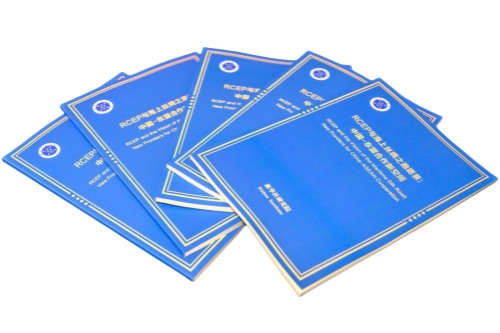
RCEP与海上丝绸之路愿景:中国—东盟合作新空间文章源自英文巴士-https://www.en84.com/16042.html
RCEP and the Vision of the Maritime Silk Road: New Frontiers for China-ASEAN Cooperation文章源自英文巴士-https://www.en84.com/16042.html
文章源自英文巴士-https://www.en84.com/16042.html
新华社研究院文章源自英文巴士-https://www.en84.com/16042.html
Xinhua Institute文章源自英文巴士-https://www.en84.com/16042.html
文章源自英文巴士-https://www.en84.com/16042.html
目录文章源自英文巴士-https://www.en84.com/16042.html
Table of Contents文章源自英文巴士-https://www.en84.com/16042.html
文章源自英文巴士-https://www.en84.com/16042.html
前言文章源自英文巴士-https://www.en84.com/16042.html
Introduction
第一章 实践:推动区域合作共赢成果丰硕
Chapter 1 Practice: Fruitful Outcomes from Promoting Regional Cooperation with Win-Win Benefits
一、RCEP推动区域经贸繁荣发展和经济一体化
I. RCEP Drives Regional Economic Prosperity and Integration
(一)贸易自由化实践成效显著
1. Trade Liberalization Achieves Remarkable Results
(二)投资便利化制度激活区域投资新动能
- Investment Facilitation Mechanisms Unleash New Momentum for Regional Investment
(三)产业加速融合推动区域经济一体化
- Accelerated Industrial Integration Drives Regional Economic Integration
二、合作共建 “21世纪海上丝绸之路” 硕果累累
II. Fruitful Outcomes in Jointly Advancing the 21st Century Maritime Silk Road
(一)大通道建设促进区域互联互通提质升级
- Major Corridor Development Upgrades Regional Connectivity and Integration
(二)“小而美”项目扎实推进惠民生
- Solid Progress in “Small yet Smart” Projects Benefit the People
(三)“数字”“绿色”成为创新合作关键词
- “Digital” and “Green” Become Key Words in Innovation Cooperation
(四)人文交流促民心相通增区域互信
- People-to-People Exchanges Enhance Mutual Understanding and Regional Trust
第二章 机遇:以开放理念引领区域经济一体化
Chapter 2 Opportunities: Advancing Regional Economic Integration with an Open Vision
一、加强政策对接,提升区域机制规则一体化水平
I. Strengthening Policy Coordination and Advancing the Integration of Regional Institutional Rules
二、密切产业协同,推进区域产供链一体化建设
II. Enhancing Industrial Collaboration and Advancing Regional Supply Chain Integration
三、聚焦互联互通,助力区域经济节点崛起
III. Focusing on Connectivity to Foster the Rise of Regional Economic Hubs
四、坚定携手合作,共同应对外部风险挑战
IV. Strengthening Collaborative Resolve to Jointly Address External Risks and Challenges
第三章 展望:构建更为紧密的中国-东盟命运共同体
Chapter 3 Vision: Building a Closer China–ASEAN Community with a Shared Future
一、用好中国高水平对外开放空间,构建更高水平RCEP
I. Leveraging China’s High-Standard Opening-Up to Build an Upgraded RCEP
二、促进区域互联互通和产供链高质量融合发展
II. Promoting High-Quality Integrated Development of Regional Connectivity and Industrial and Supply Chains
三、深化人文交流,夯实合作民意基础
III. Deepening People-to-People Exchanges to Strengthen the Public Foundation for Cooperation
结语
Conclusion
编写说明与致谢
Writing Explanation and Acknowledgments
前言
Introduction
“让我们把人民对美好生活的向往放在心头,把维护和平、促进发展的时代使命扛在肩上,携手前行,接续奋斗,构建更为紧密的中国—东盟命运共同体,共创更加繁荣美好的地区和世界!”
“Let us keep close to our hearts people’s aspiration for a better life, and put on our shoulders the mission of our times to safeguard peace and promote development. Let us work hand in hand to build on what has been achieved and work toward a closer China-ASEAN community with a shared future, and make our region and the world even more prosperous and beautiful.”
——中国国家主席习近平
– PRC President Xi Jinping
2024年12月30日,一列满载90个集装箱印尼起酥油、海南椰子汁等货物的海铁联运班列,从中国钦州铁路集装箱中心站发出,驶向重庆团结村站。这是2024年西部陆海新通道班列开行的第10000列联运班列。北接丝绸之路经济带、南连21世纪海上丝绸之路,西部陆海新通道不断加快建设步伐。2024年,西部陆海新通道铁海联运外贸发运128651标箱,同比增长24%,其中《区域全面经济伙伴关系协定》(RCEP)成员国经新通道运输货物87846标箱,占新通道总运量的17%,同比增长32% 。这是RCEP与共建 “海上丝绸之路”成果效应叠加的小小缩影。
On December 30, 2024, a sea-rail intermodal freight train carrying 90 containers of Indonesian shortening, Hainan coconut juice, and other goods departed from the Qinzhou Railway Container Center Station in China, bound for Tuanjie Village Station in Chongqing. The departure of this train marked the 10,000th intermodal freight train of the year on the New International Land-Sea Trade Corridor. Linking the Silk Road Economic Belt in the north with the 21st Century Maritime Silk Road in the south, the New International Land-Sea Trade Corridor has continued accelerating its development. In 2024, the corridor handled 128,651 twenty-foot equivalent units (TEUs) of foreign trade via sea- rail combined transport, representing a year-on-year increase of 24%. Of these, 87,846 TEUs were goods from member countries of the Regional Comprehensive Economic Partnership (RCEP), accounting for 17% of the total freight volume – an increase of 32% over the previous year. This achievement offers a glimpse into the synergistic effects of RCEP and the joint efforts to build the Maritime Silk Road.
2025年是RCEP实施生效三周年,也是中国提出《推动共建丝绸之路经济带和21世纪海上丝绸之路的愿景与行动》十周年。作为两大多边合作框架的主导者,中国与东盟推动海上丝绸之路与RCEP协同共建,探索出不同于传统贸易投资框架、更加平等互利、合作共赢的模式,有效增强区域互信,提高区域国际影响,强化区域产供链融合韧性,推动完善全球经济治理体系。
2025 marks the third anniversary of the implementation of RCEP and the tenth anniversary of China’s release of the Vision and Actions on Jointly Building the Silk Road Economic Belt and the 21st Century Maritime Silk Road. As a leading force behind these two major multilateral cooperation frameworks, China and ASEAN have worked together to align the development of the Maritime Silk Road with RCEP, creating a model that departs from traditional trade and investment frameworks – one that is more equitable, mutually beneficial, and win-win in nature. This collaboration has effectively strengthened regional trust, enhanced the region’s international influence, and reinforced the resilience and integration of regional industrial and supply chains, thereby contributing to the improvement of the global economic governance system.
在双方共同推动下,中老铁路、金港高速公路和雅万高铁等一系列中国—东盟合作标志性项目陆续建成,有效缓解地区基础设施投入不足、区域互联互通相对滞后等发展瓶颈。中国和东盟双边贸易额2024年已达9823亿美元,比2013年增长了1倍多。双方已连续5年互为最大贸易伙伴。中国—东盟自贸区3.0版谈判实质性结束,有望进一步降低关税和非关税壁垒,提升贸易投资自由化便利化水平,助力东盟地区发展,推动区域经济一体化。
With the concerted efforts of both sides, a series of landmark China-ASEAN cooperation projects – such as the China-Laos Railway, the Phnom Penh-Sihanoukville Expressway, and the Jakarta-Bandung High-Speed Railway – have been completed in succession. These projects have effectively eased development bottlenecks in the region, including insufficient infrastructure investment and underdeveloped regional connectivity. In 2024, bilateral trade between China and ASEAN reached 982.3 billion USD, more than double the figure in 2013. The two sides have remained each other’s largest trading partners for five consecutive years. Negotiations on Version 3.0 of the China ASEAN Free Trade Area have been substantively concluded, which is expected to reduce tariff and non-tariff barriers further, enhance trade and investment liberalization and facilitation, support development across the ASEAN region, and advance regional economic integration.
展望未来,中国—东盟合作不仅将为区域繁荣发展注入新动力,还将有力推动区域外RCEP成员和共建“一带一路”国家共同发展。在百年未有之大变局加速演进背景下,中国—东盟合作共同维护多边自由贸易体制,营造开放、包容、非歧视的国际合作环境,推进普惠包容的经济全球化,推动构建人类命运共同体。
As we look ahead, China-ASEAN cooperation will not only inject fresh momentum into regional prosperity and development but also help drive the collective growth of RCEP member states beyond the region and countries participating in the Belt and Road Initiative (BRI). Against the backdrop of accelerating changes unseen in a century, China and ASEAN are working together to uphold the multilateral free trade system, foster an open, inclusive, and non-discriminatory environment for international cooperation, advance inclusive and beneficial economic globalization, and promote the building of a community with a shared future for humanity.

